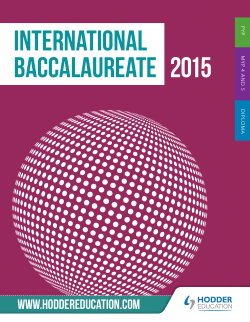
MYP: The next chapter Page 1
MYP: The next chapter Page 1 MYP around the world November 2011: 917 schools (in 81 countries) AFRICA, EUROPE, MIDDLE EAST 149schools AMERICAS: 651 schools ASIA PACIFIC: 117 schools 2 Key challenges for MYP Access for schools with national/state curriculum Continuum between IB programmes Age appropriateness © International Baccalaureate Organization Key challenges for MYP Choice of subjects Fewer layers Easy to implement Online curriculum tool Action International Recognition and assessment development Innovative Continuum between IB programmes Alignment of the core of the IB programmes UK Access for schools with national/state curriculum ATL Criterion related Global contexts Age appropriateness Re-design of programme model © International Baccalaureate Organization Externally validated assessment Prescribed concepts Innovative Learner Global contexts MYP puzzle Profile Approaches to learning Summative assessment Action Subject Groups Inquiry Areas of interaction InterConcept disciplinary based learning © International Baccalaureate Organization Where are we with MYP: the Next Chapter ? • Decisions: Proposed changes are still in development and have not yet been approved. • Pilots: Aspects of the proposed changes are being piloted and final decisions will be taken as the outcomes of these pilots become clear. • Transition: The IB will guide schools in a gradual process and give maximum notice of change. The IB is mindful of the need for schools to be able to allocate resources efficiently. 6 Curriculum development • Contextual learning – Evolution of areas of interaction to global contexts • Conceptual framework – Key and related concepts – Disciplinary understandings – Central ideas • Curriculum planning • Alignment across PYP, MYP and DP 7 Approaches to learning (ATL) • • • • ATL to become part of all three programmes Much stronger emphasis Related to command terms Divided into five skills areas common with PYP and DP: Communication Social Self-management Research Thinking • Not subject specific, but guides will include subject specific examples © International Baccalaureate Organization Timeline of curriculum development • Develop guides by 2014 • No guides or TSMs will be published after 2012 until the launch of MYP: the next chapter suite of documents • Gathering feedback through: a) b) c) d) Surveying schools School visits and in conferences Curriculum review meetings and piloting of draft guides Informal feedback received from a range of stakeholders including MYP & DP students 9 MYP internal assessment Developments: • All subjects are moving to four criteria • Mandated interim criteria and objectives for MYP1 and MYP3 will be proposed • Command terms will be used to define levels of the criteria in all subjects • Common criteria will be aligned across subjects where applicable • Monitoring of assessment will continue – Investigating whether online training for moderators could be made available as professional development for all MYP teachers. 10 Final Assessment Year 3/4: Year 5: Culminating task Mandatory: • Moderation of personal project Optional: • External summative assessment • Monitoring © International Baccalaureate Organization Potential assessment model Investigation is being done into the following model: • External assessment in MYP year 5: – – – – – Will be optional Electronic, criterion related assessment Disciplinary and interdisciplinary components Based on key concepts and developed around global issues Will be piloted and aims for recognition • Mandatory moderation for the personal project • Subject moderation would be phased out 12 Subject groups • The MYP will remain an octagon and will not move towards a hexagon. • Investigation of a flexibility option for schools that have difficulty offering all eight subject groups in MYP years 4-5: Students may have a choice of subject groups in years 4 and 5 of the programme: – Minimum of six subject groups must be studied concurrently – Language B (or second Language A) mandatory for all students in all years • Currently being piloted in schools to study the effects on teaching and learning 13 Feedback from schools Survey sent to coordinators in all IB World Schools, both to schools that had or did not have MYP (May 2011) • MYP schools: 94% of respondents considered that, taken together, they would view the changes as being positive in their school • IB schools without MYP: 91% of respondents considered that, taken together, they would view the changes as being positive and would consider implementing the MYP in their school. 14 Summary of key developments Significant concepts Areas of interaction (AOIs) Eight subject groups Optional moderation Certificate of Achievement Guides Teacher support materials Curriculum Assessment Support Prescribed concepts with illustrative content Potential replacement of AOIs with global contexts Choice of subjects years 4-5 Optional external summative assessment (e-assessment) Compulsory PP moderation Year 3/4 culminating task Guides Teacher support materials © International Baccalaureate Organization Engaged students motivated teachers improved preparation for DP recognition and accreditation more children benefitting from the MYP Proposed Timeline 2011 Development: • Core • Programme model • Concepts • Pilot subject options 2012-2014 Subject guides; authorization and evaluation; Professional development; assessment; piloting all new elements 2014 Launch, with first assessment 2015 © International Baccalaureate Organization Transition • Professional development will start including new elements for curriculum planning starting in 2012 • Transition document for schools and IB educators for the interim period until 2014 • Transition document for schools and IB educators when the new documents are published in 2014 17 Background information If you are interested in some of the literature that has informed the discussions so far: Tomlinson, C. A., Kaplan, S. N., Renzulli, J. S., Purcell, J. H., Leppien, J. H., Burns, D. E., Strickland, C. A., & Imbeau, M. B. (2008). The Parallel Curriculum: A design to develop learner potential and challenge advanced learners (2nd edition). Thousand Oaks, CA: Corwin Press. Erickson, HL. Stirring the Head, Heart, and Soul: Redefining Curriculum, Instruction, and Concept-based Learning, c. 2008, Corwin Press Pub Willingham, D. (2009). Why don't students like school: A cognitive scientist answers questions about how the mind works and what it means for the classroom. San Francisco, CA: Jossey-Bass. Tomlinson, C. & McTighe, J. (2006). Integrating differentiated instruction and understanding by design. Alexandria, VA: ASCD. National Research Council. (2000). How people learn: Brain, mind, experience and school. Washington, DC: National Academy Press. Page 18 Keep up to date You can find and post messages about the MYP using: @IBMYP For instant updates and MYP news Page 19 Questions If you have any questions about this review or any suggestions, please contact ibid@ibo.org Page 21
© Copyright 2025


















